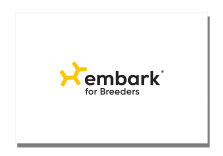Hereditary Cataracts
Cataracts are the result of a progressive disease of the lens. The lens is normally a transparent structure of precisely organized fibers that lives in the pupil and focuses light. Cataracts cause the lens fibers to become disordered and turn the lens into a milky blue color. The lens is no longer transparent, light fails to reach the retina, and blindness is the end result. With this genetic mutation, dogs can develop cataracts at only a few weeks to months of age.
-
Signs and symptoms
Affected dogs first show a cloudy haze in their pupil that gradually becomes more milky blue to crystalline in appearance. Vision worsens, and dogs may bump into furniture, be more hesitant on steps, and run into walls or doorways.
While cataracts are typically a disease of the senior dog and can be associated with other eye diseases (these would be termed secondary cataracts), mutations in the FYCO1 gene cause cataracts to form at an accelerated rate in young puppies (around 8 weeks of age). -
Diagnosis
Veterinarians will examine your dog’s eyes and may use a light or lens to assist in the diagnosis. Please note that there are other ocular diseases that are commonly mistaken for cataracts so be sure to have your dog evaluated by a veterinarian.
-
Treatment
Surgical correction by a veterinary ophthalmologist is currently the only treatment available to restore your dog’s vision. The other alternative is careful monitoring and lifestyle changes to make your dog’s blindness more manageable.
-
What to do if your dog is at risk
Actions
- Talk to your vet about your dog’s hereditary cataracts result so you can work together to plan regular eye exams and monitoring.
- Schedule veterinary eye exams to track any changes in the lens and discuss whether a referral to a veterinary ophthalmologist may be helpful.
- Watch for signs of vision changes, such as cloudy eyes, bumping into objects, or hesitation in dim light, and contact your vet if you notice any of these signs.
-
Genetic Information
This variant was first described in the Wirehaired Pointing Griffon.
This variant is inherited in an autosomal recessive manner, meaning a dog requires two copies of the variant to show signs of Juvenile Cataract.
Gene names:
FYCO1 Exon 8 ‐ chr
Inheritance type:
recessive
Citations:
-
Breeds affected
This health condition affects the following breeds
Learn about your dog’s unique genetic health
Dog owners
Breed identification, health and trait insights, personalized care recommendations, and the world’s first canine relative finder—all in one leading dog DNA test.
Learn about the report for dog ownersShop the test
Breeding programs
Embark’s test for breeding programs is one comprehensive DNA test designed with your needs in mind.
Learn about the report for breedersShop the test












